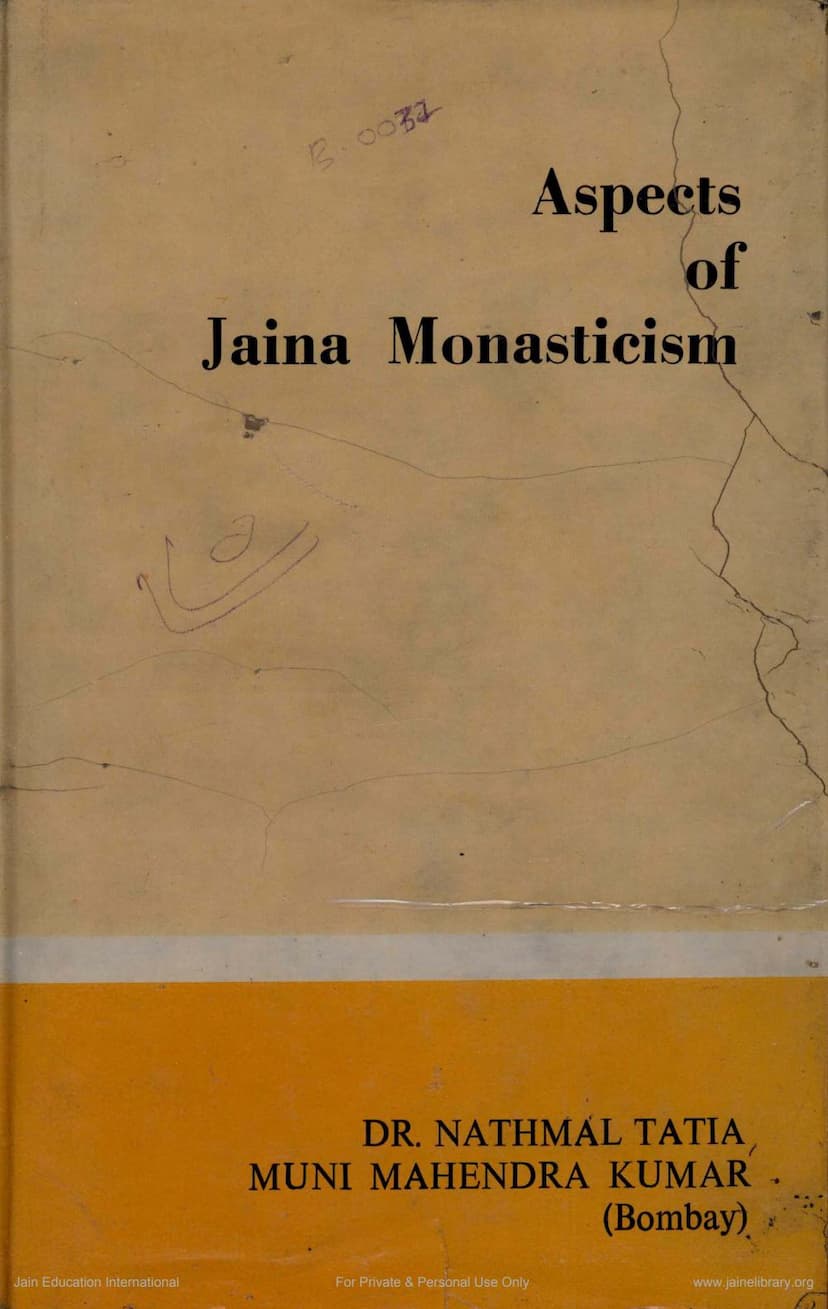Aspects Of Jaina Monasticism
Added to library: September 1, 2025

Summary
This document is a comprehensive summary of the book "Aspects of Jaina Monasticism" by Dr. Nathmal Tatia and Muni Mahendra Kumar, published by Jain Vishva Bharati. It serves as a prelude to the forthcoming Encyclopaedia of Jainism by the same publisher.
The book offers a historical and comparative study of various facets of Jaina monasticism, aiming to provide a comprehensive and critical view of the selected topics. Its value is further enhanced by its ability to position Jaina monastic practices within the broader context of other monastic systems.
Key Themes and Chapters:
The book delves into various aspects of Jaina monastic life, organized into several chapters:
-
Chapter I: The Five Vyavahāras or The Sources of Monastic Legislation: This chapter outlines the five authorities for Jaina monastic law: Agama (scripture), Suya (sacred texts derived from scriptures), Ānā (sanction of a competent Ācārya), Dhāraṇā (rules formulated after careful consideration of texts), and Jiya (customs and conventions). It also provides comparative insights into the sources of monastic law in Buddhism and Brāhmanism.
-
Chapter II: The Sāmācārī or The Ten Rules of Monastic Deportment: This chapter explains the meaning of Sāmācārī as right conduct and outlines ten specific rules governing monastic behavior, including Icchākāra (voluntarism), Micchākāra (repentance), Tahakkāra (assent), Āvassiyā (awareness of leaving the abode), Nisīhiyā (awareness upon return), Appucchaņā (seeking permission), Paḍipucchaņā (confirmation of permission), Chandaņā (inviting others to partake), Abbhutthāna (rendering services), and Uvasampayā (approaching a teacher in another gana for special knowledge).
-
Chapter III: The Asamahithāņas or The Twenty Occasions of the Imbalance of Mind: Based on the Ayāradasão, this chapter details twenty specific instances that lead to mental imbalance in monks, such as walking quickly, finding fault with superiors, anger, indulgence, and raising disputes. It also draws parallels with similar rules in Buddhism and Brāhmanism.
-
Chapter IV: The Sabalas or The Twenty-One Types of Monks with Tainted Conduct: This chapter explains the Prakrit term "sabala" meaning a taint or blemish in a monk's conduct. It lists twenty-one types of tainted conduct, ranging from masturbation and sexual intercourse to various forms of deceit and transgression, and compares these offenses and their punishments with those in Buddhism and Brāhmanism.
-
Chapter V: The Four Stages of Sin: This chapter, drawing from Jaina, Buddhist, and Brahmanical literature, discusses the concept of sin and crime in stages, from intention to misconduct and final indulgence. It compares these stages and punishments with modern legal frameworks, highlighting parallels in the classification of homicide in English law.
-
Chapter VI: Āsāyaṇā or Disrespectful Conduct: This chapter lists thirty-three types of disrespectful conduct according to the Ayāradasão and Āvaśyaka Sūtra, detailing offenses related to disrespect towards superiors, scriptures, and fellow monks. It also presents comparative lists from different texts and discusses the Buddhist and Brahmanical perspectives on similar conduct.
-
Chapter VII: Gaņisampadā or The Qualifications of the Ganin (Religious Head): This chapter outlines the eight qualifications of a Jaina religious head (Ganin), covering conduct, learning, personality, diction, exposition, perception, apt application, and comprehensive planning. It also details the Vinaya-padivatti (discipline) of the Acārya and the Antevasin (student), with comparative notes from Buddhist and Brahmanical traditions.
-
Chapter VIII: Cittasamāhitthāņas or The Ten Stages of the Concentrated Mind: This chapter provides a systematic exposition of the stages of spiritual development in Jainism, starting from preliminary conduct and progressing through meditation to various levels of enlightenment. It describes ten stages, including knowledge of things, memory of past lives, dreams, visions, clairvoyance, telepathy, pure knowledge, pure intuition, and disembodied existence, drawing parallels with Buddhist and Yogic concepts.
-
Chapter IX: The Four Monastic Courses: This chapter describes four distinct monastic paths:
- Sthavira-kalpa (The Course of the Elders): This is designed for ordinary human beings and involves initiation, training, comprehension of meaning, life of a wanderer, consummation, itinerary, deportment, and essential features.
- Jina-kalpa (The Course of the Victors): This path emulates the ascetic life of Lord Mahāvīra and is characterized by eremitical life, intense penance, and self-mortification.
- Parihāra-viśuddhikā or Suddhaparihārikā (Purificatory Cooperative Course): This course is for those unable to fully undertake the Victor's Course and involves purification through cooperative practice.
- Yathālandaka (The Time-bound Course): This course is characterized by limited stays in villages or towns and has specific rules for begging and conduct.
-
Chapter X: The Ideal Monk: This chapter presents a versified English rendering of verses from the Uttarajjhayaṇāņi and Dasāveāliyam, describing the essential characteristics of an ideal Jaina monk, emphasizing qualities like equanimity, self-restraint, non-violence, renunciation, meditation, and tolerance of hardships.
-
Chapter XI: The Victor's Penance: This chapter offers a versified English rendering of the Uvahāṇasuyam from the Ayāro, detailing the ascetic practices of Lord Mahāvīra, which serve as an example for aspirants to Jinahood, highlighting extreme penances, solitude, and detachment.
The book also includes a detailed Bibliography of Sanskrit, Prakrit, and Pali words, as well as English words relevant to the study of Jaina monasticism, and a Corrigenda section. The publishers, Today & Tomorrow's Printers and Publishers, have also noted other relevant publications in the field of Indian religion and philosophy.